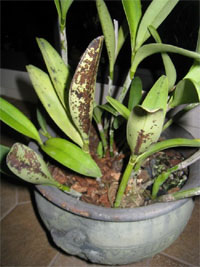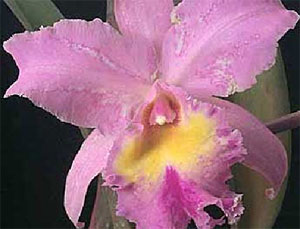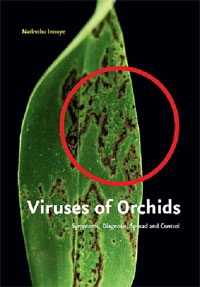Viruses in Orchids
A number of viruses are known to affect orchids.
For many years growers have been aware of Tobacco Mosaic Virus, Cymbidium Mosaic Virus, Cymbidium Necrotic Ring spot Virus and Odontoglossum Ring spot Virus. In recent times a new group of viruses known as Rhabdovirus, has been identified in collections in Australia.
|
|
 |
Even plants with no apparent symptoms may be infected, with good culture masking the effects, but eventually the signs will show through. As with other plants, sap transmission will carry virus from an infected orchid to a non infected orchid. This commonly happens with cutting implements such as scissors, secateurs, knives and the like. Plant leaves rubbing together or even just touching, on the nursery bench, during transport or at shows may also transmit virus. Touching your plants, especially running your fingers along the leaves as many growers do to kill aphids, may also transmit virus. Pollen transfer is also known to result in virus transmission.
Virus particles are very small and can enter through the tiniest of wounds on a plant, wounds that may be quite invisible to the naked eye.
After mechanical transmission, which is essentially the result of cultural techniques and practices, the next main method of virus transmission is by sucking and chewing insects. Aphids in particular are known carriers of virus and other suspects must include thrips, mealy bug, grasshoppers, Beatles (especially the Dendrobium Beetle) and scale insects.
Treatment
You cannot do anything about a plant once it is infested with virus. There is no treatment and no cure, so you must at least isolate an infected plant from no-infected plants, and preferably destroy it by burning it.
|
Plants can be tested for virus if they are valuable, but even if you only suspect the presence of virus, you must isolate these plants until they can be checked. There are commercial laboratories where this testing can be done at reasonable rates. |
 |
It sounds hard to say but you really MUST DESTROY infected plants. While they remain in your collection they are a potential source of further infection, and you run a real danger of contaminating non-infected plants, not only your own but other people's as well if you take your plants to meetings and shows.
Control
Do not use any cutting instrument from plant to plant without sterilising such instrument in between - by flame or boiling, by alcohol, or by soaking in a saturated solution of Steeri-Kleen or Trisodium Phosphate. This means any cutting of plants, including rhizomes, stems, leaves, inflorescences and flowers.
Do not unnecessarily touch or handle your plants, and especially keep your hands off other people's plants at meetings and shows.
When working on your plants (re-potting, potting-on, grooming etc) keep your work surfaces clean and use fresh sheets of newspaper between each plant. When you have finished with a particular plant, wrap up all plant debris, old potting material, pots, stakes and the like in newspaper sheets you have been working on, and dispose of the package. Then wash and dry your hands, lay out fresh sheet of newspaper, and start on the next plant.
|
|
 |
Your claim to Fame is a Fame Orchid













